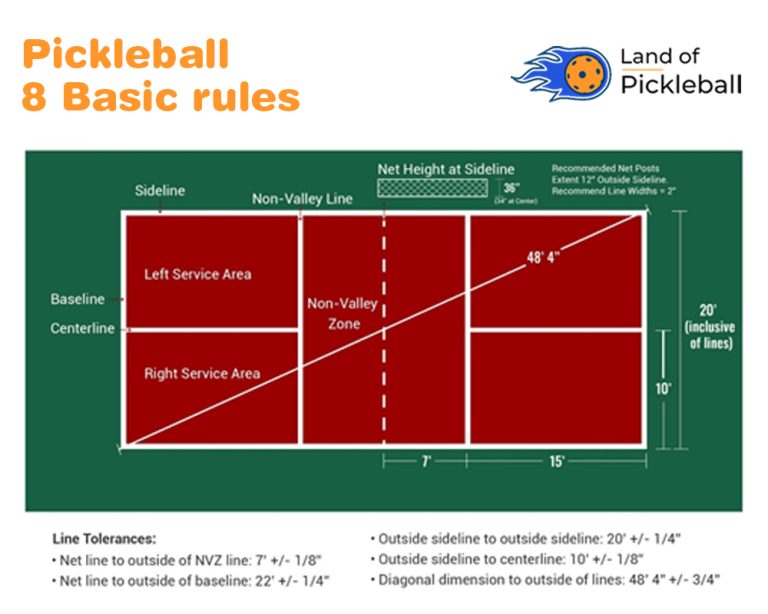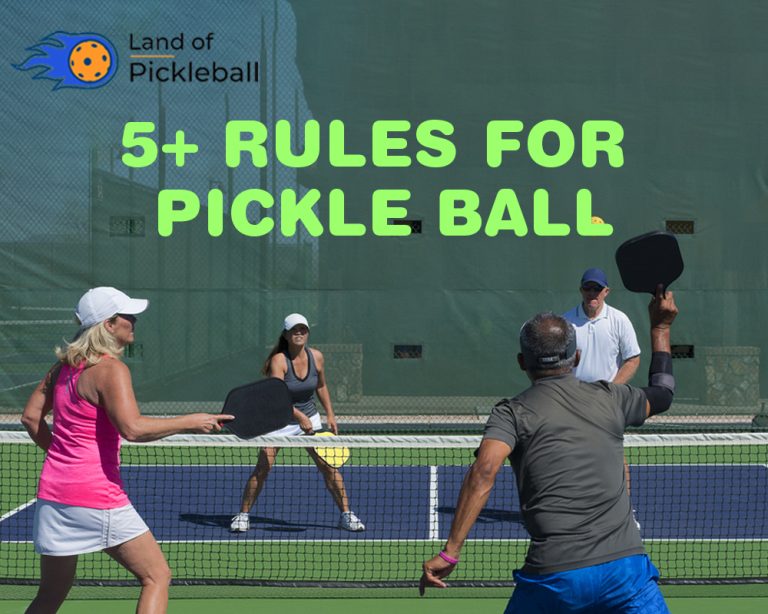Double Bounce Rule in Pickleball Definitive Guide
Double Bounce Rule In Pickleball ensures each side makes one groundstroke before volleying after the serve, preventing double bounces for fair play.
Before 2018, it was well-known by the name Double Bounce rule, and after that, it was officially announced as the Two-bounce rule. “While playing Pickleball, the ball is served; the receiving Team lets the ball bounce before returning it. Meanwhile, the serving team allows it to bounce before return.”
Two-Bounce Rule – Once the ball bounces on each side of the Pickleball court
Double Bounce – Considered as the fault when your ball bounces two times on each side
Double Bounce Rule In Pickleball
The rule is initiated with two shots while playing the Pickleball game. You must know that these shots would be the first two of your game; the serve shot and the return shot of the serve. Players let the ball bounce to the ground after each shot.
The double bounce rule pickleball is achieved when the server and the receiver let their ball bounce once on each side. The rest of the match continues with a groundstroke (the ball bounces before the player strikes it) or a volley (shot take-out of the air).
Who created the Double Bounce Rule in Pickleball?
Joe Pritchard and Bill Bell created Pickleball in 1965. Both fathers created this paddle game on their personal backyard court to entertain their kids on the summer days evening. So you may know how the game started, and Pickleball rules were established for the appropriate gameplay.
Why does the Double Bounce Rule Pickleball Exist?
No-bounce Rule: The first serving team shot the ball towards receiving team. The receiving team is outside the NVZ line and can catch the shot from the air. Hence, they can volley back to the first serving team that lands it into the NVZ. The first-serving player is away at baseline and may lose this shot due to other serving requirements.
It might not be very clear for beginners. Although, if you’re a racquet sports player, this rule excites you to play the game. It’s quite favorable for players with a tennis background. We often volley to our third shot. It appears against all the rules, and we are prohibited from doing this. There is a major reason behind this rule.
Reason for Double Bounce Rule Pickleball
Pickleball players can get longer rallies with this rule in a great tournament. This exclusive rule is invented for Pickleball, not for tennis and table tennis.
It protects the serving team from crashing the court net instantly after playing the serve. It creates the most beneficial circumstance to get to the endpoint rapidly. It’s the best pick if the server has accomplished the good serve, it would lead the receiving Team to make the weak return, and the point benefits the serving team.
The ball is in your court while playing the Pickleball serving match. It leads to the best point in other tennis games where the server may crash the court’s net after the serve.
Double Bounce Rule Pickleball
The Concept of Official Rule Book USAPA
The double bounce rules Pickleball from the standard Pickleball tournament are stated as follows:
Make a Serve and the Return Shot
The server player enables to hit the serve diagonally to the half of the court to them and beyond the NVZ line. On the other hand, the receiving player lets it bounce at once and then returns to the first-serving Team’s side. Likewise, the serving team will let it bounce and return it to receiving players. After that, any shot can be played (before or after the bounce) before the next serve. Hence, this rule has eliminated the volley advantage, and then serve with also extends the rallies.
Double Bounce Rule Pickleball Example (Doubles Team)
There are two teams to play the Pickleball match, Team A & Team B. the referee flips the coin and announces that Team B is playing as the serving team.
The Team B players are on the right hand of the court Pickleball behind the baseline. The server player calls the 0,0,2 scores and is ready to serve the ball first. He is behind the baseline at the middle side of the court and applying the serve by an underhand stroke along with his below-waist contact point.
Ball rotates diagonally to the Team A side. This Team A stays far back in the Pickleball court, letting the coming shot bounce at once. Then they hit the shot back aggressively and forced Team B to drop back, and the shot landed close to the baseline—the deep return, an amazing strategy in the Pickleball game.
However, Team B allows the ball to bounce on the ground once before touching their paddle to the ball (2nd bounce of Double Bounce Rule Pickleball). That player may stand near the back of the court and must drop the back serve if he wants to get the point.
He can connect with the ball proficiently by bouncing it, sending it back over the net, and playing the next level. Both teams proceed the game back and forth (also known as the rally/point). Only the serving team is getting the score point.
Ultimately, Team A hits the shot, but Team B misses; no score is made for team A or Team B. Here, the sideout happens, and the serve moves to Team A. They are in the right-hand corner of the court.
First Server Exception
This rule is stated as the first player of the pickleball sport who is capable of serving (making score) while his Team is serving the game is known as a server player. After each sideout, all the players would become proficient in serving.
The Team A server calls the scorecard 0,0,1 and diagonally serves the ball towards the first serving team B. Team B lets it bounce on the court and then returns to the currently serving team A.
If team B loses its chance to hit the ball and this score goes to Team A., this server player moves to the left corner of the court and calls 1,0,1, then serves his ball.
Now the double bounce rule Pickleball is entirely completed, and gameplay will continue until a team scores 11 points (with the leading 2 points). That Team will win the contest today.
Tips for conquering the Double Bounce Rule Pickleball
Receiving side tips for Singles Gameplay
The reason for this position is that when a player stands towards the back side of the court, he is less tempted to catch the coming ball before bouncing. The back position is fairly best for performing the Double bounce rule while playing.
Serving side tips for Singles Gameplay
It represents that you’re not interested in getting the advanced level of the game into your court. You risk receiving the bad catch if the opponent team returns the ball to the baseline. That position will be behind your side. So to acquire the bounce behind the server is quite problematic and hard. He may never make the shot and lose his returning shot.
Tips for Doubles Game
The serving team players launch the match from behind the baseline for 2nd bounce of this rule. “The server and his partner player should remember to start their point from behind the side of the baseline”.
The double bounce rule Pickleball is tough for the serving team due to 2nd bounce.
FAQs
Conclusion
The receiving and serving teams must allow the ball to bounce before returning to the other team. These two bounces are essential to perform while playing and are denoted as the Double Bounce Rule Pickleball. Moreover, this extraordinary rule has extended the rallies and provided more strategically played rallies as well.





